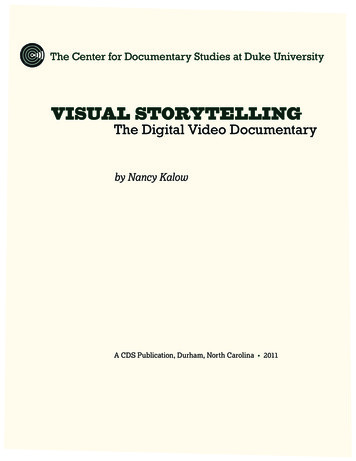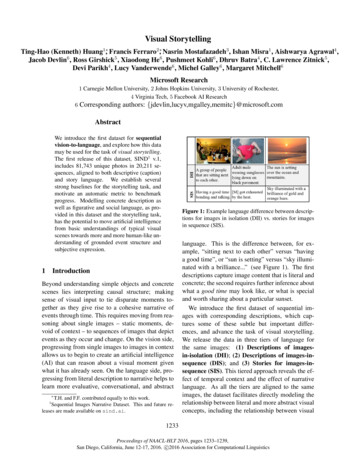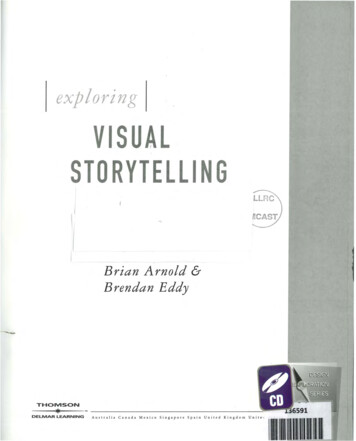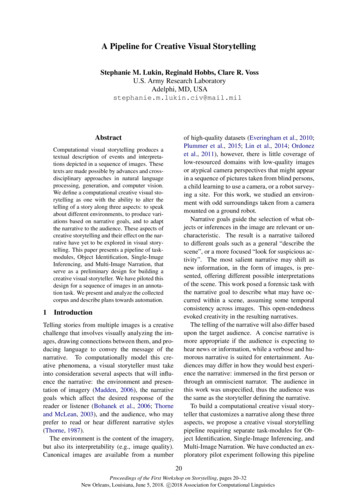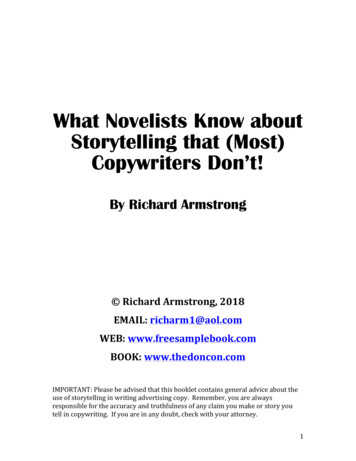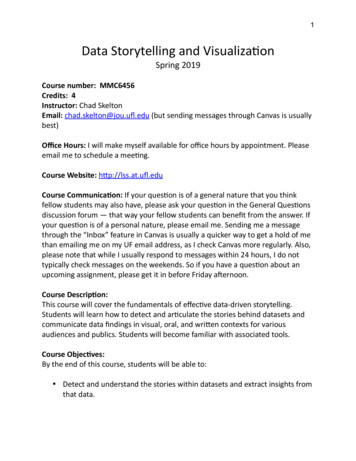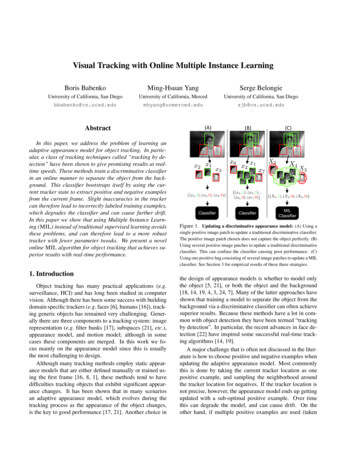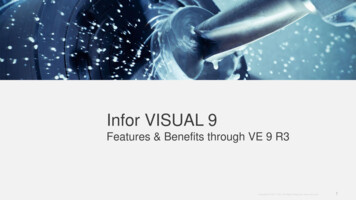
Transcription
VISUALSTORYTELLINGA BRIEF PRACTICAL GUIDE
WHY VISUAL STORYTELLINGVisual storytelling has not been an overnight sensation, but instead it has been the result of a continued evolution of socialmedia platforms, along with user and organizational behaviors.Research indicates that consumer interest in visual content isn’tnecessarily just a preference; it’s actually easier and faster forhumans to process. The right picture can go further than justtelling your story visually; it can make you feel emotions, evokememories, and even make you act differently. Humans are wiredto process visuals differently than text and to respond differentlyto pictures than to words. Although human communication hasexisted for about 30,000 years, it has been only in the last 7,000
In the 1960s, Professor Albert Mehrabian showed that 93% ofcommunication is in fact nonverbal.18 By this he meant thatmost of the feelings and attitudes of a message come from thefacial expressions and the way the words are said, and the rest,only 7%, derives from the actual words being spoken. It isn’teven just the meanings of a message that are conveyed moreprecisely by visual information. Even issues of trust and credibility are carried by images far more so than text.Here are some facts to keep in mind:We are wired for visual storiesAlthough human communication has existed for about30,000 years, it has been only in the last 7,000 years that humans developed a written language. Painting was the onlyway to convey a message visually. Then came writing andthe printing press. Humans evolved over millennia to respond to visual information long before they developed theability to read text.
We suffer from informationoverloadWe receive 5x as much informationtoday as we did in 1986.34 gigabytes or 100,500 words – theamount of information we consumeoutside of work on an average day.[10]On average users only read 28% ofwords per visit.Shortened attentionspan14% increase in page views is seenwhen press releases contain a photo.The average modern adult attention span is somewhere between46.1% of people say a website’s design is the number one criterion fordiscerning the credibility of an organization.2.8 and 8 seconds.94% more total views on average are attracted by content containing compelling images thanPublishers who use infographics growin traffic an average of 12% more thanthose who don’t.Posts with videos attract three timesmore inbound links than plain textposts attract.Viewers spend 100% more time onpages with videos.Including a photo and a video in apress release increases views by over45%.
WHAT VISUAL STORYTELLINGWhat is visual storytelling?To use video, pictures, symbols, colors, andwords to communicate ideas, illustrate information or express relationships visually.Visual storytelling is about making complexinformation easier to understand. Compelling Visuals grab people’s attention.It takes many forms and appears in manymedia. Some familiar forms include video,animation, charts, graphs, maps, diagramsor timelines.It tells a story with visuals. It can tell “howmany?” “when?” or “where?” It can showtrends over time, compare elements or reveal hidden patterns.What is not visual storytelling?It is not the same as graphic design,film-making nor is it only about making something aesthetically pleasing. It’s not aboutbranding, style, making a glossy product orsomething that looks “corporate.”Visual storytelling is not just a matter of making text pretty or entertaining, but of shaping understanding and clarifying meaning.
ELEMENTS OF VISUAL STORYTELLINGIn order to develop and implement a successful visual storytelling strategy, storyteller must focus on manyelements. But among all of them, the most important isthe storytelling itself.All of the succesful visual storytelling examples provethat the content’s storytelling element is as just as important as the use of the visuals. Even it would not beexaggaration having a story is more than visual itself.That is the reason why we should focus on what storytelling is first.Storytelling TechniquesThe monomyth (also called the hero’sjourney), is a story structure that is found in many folk tales, myths and religious writings from around the world.In a monomyth, the hero is called toleave their home and sets out on a difficult journey. They move from somewherethey know into a threatening unknownplace.Good for:Taking the audience on a journeyShowing the benefit of taking risksDemonstrating how you learned somenewfound wisdom
The mountain structure is a way of mapping the tension and drama in a story. It’ssimilar to the monomyth because it helpsus to plot when certain events occur in astory.climactic conclusion.It’s different because it doesn’t necessarily have a happy ending. The first partof the story is given to setting the scene,and is followed by just a series of smallchallenges and rising action before aGood for:Showing how you overcame a series ofchallengesSlowly building tensionNested loops is a storytelling techniquewhere you layer three or more narrativeswithin each other.and use the stories around it to elaborateor explain that central principle.It’s a bit like a TV series – each episodehas its ups and downs, all building up toa big finale at the end of the season.Good for:You place your most important story –Explaining the process of how you werethe core of your message – in the centre, inspired/ came to a conclusion
In medias res storytelling is when youbegin your narrative in the heat of theaction, before starting over at the beginning to explain how you got there.By dropping your audience right into themost exciting part of your story they’ll begripped from the beginning and will stayengaged to find out what happens.Good for:Grabbing attention from the startKeep an audience craving resolutionFocusing attention on a pivotal momentin your story
PARTS II
Success Factors for Visual StoryThe efficiency of a visual story by its capacity to:Engage and entice: its ability to get attention, often through anarresting or memorable image,Communicate a convincing argument: summarising complexconcepts in a way that the intended audience will respond to,Draw the viewer in: giving them a way to connect directly to thecontent or explore the issue further.A Good Visual Campaign.In visual campaigns, a significant part of the job ofexpressing how things are, how they ought to be. Whetherdirectly presented or implied, in any good visual campaignyou should be able to read a visual argument: the facts ofthe matter and the problem, the implied promise of the futureand the implied justification for change.
28.12.2016What Can Go Wrong?visual information aimed at people who are not ready toreceive it or don’t share our understanding of the probleman image that people cannot bear to look at because it is toostrong, such as explicit documentation of a tragedy, will notenlist support and, worse, may be perceived asmanipulation.a campaign that makes use of the wrong technologyplatform for its particular audience will not reach it.Then how?There are many ways to tell a story or to present data. Howdo you know what kind of presentation to use?The main thing to consider is: which archetypes will helpyou to communicate your message?
ANALOGYElephant’s fear of the mouse
COMPAREPROVOKE
MAKE CONNECTIONSdirect consumptionof water throughvisible, everydayacts such asflushing a toilet, andthe indirect, invisibleconsumption ofwaterPERCEPTIONS- MATERIALIZE ITIn trying tounderstand anissue, we are oftenasked tocomprehendmeasurements thatare difficult tograsp.
COMEDYhttps://w w w .youtube.com /w atch?v oJLqyuxm 96kWHAT CAN GO WRONG AGAIN?Visual Cliches - Thehazards of overdoing itand relying too much ongrabbing attentionquickly, without offeringuseful or insightfulinformation.
https://www.youtube.com/watch?v mOBv2Cx8WIEhttps://www.youtube.com/watch?v o7E-Ym5LEJA
STORYTELLING VIAVIDEOGRAPHY &PHOTOGRAPHYhttps://www.youtube.com/watch?v ICcE72RwEyc&index 1&list WL
SHOT COMPOSITIONAll great pictures and videos have one thing in common — they are well composed. Composition— also called “framing” — is fun to talk about, because there is no right or wrong. The onlyrule is that there are no rules. But there are a few tips to help you take better pictures:FRAMINGPay attention to framing. Nothing ruins aphoto faster than distracting elements in thebackground. Don’t get so focused on thephoto’s subject that you ignore what else isgoing on around them. Watch out for poles,trees and power lines, and look all the wayaround the edges of the frame, asking “Is thiswhat I really want?”RULE OF THIRDSLearn the Rule of Thirds. The human eye has its “visual center” and this is the place that it isnaturally drawn to. Imagine the viewfinder is divided into thirds, both horizontally and vertically.This grid creates four points where the lines cross. For the greatest impact, place the subjectwhere the lines intersect, instead of in the center of the frame.Third LinesIntersectionsThird Lines1/31/31/3
FOREGROUND AND BACKGROUNDEvery photo has a foreground and abackground. How you want people to lookat your picture tells you what to do with theforeground and background. To blur thebackground, zoom in close and choose alarge aperture setting (like F2.8). This worksreally well for pictures of a person.LINE OF SIGHTChange your line of sight. Try kneeling, oreven putting the camera on the ground. Orclimb a flight of stairs so you’re higher thanthe subject you’re photographing. Digitalcameras with twist and tilt LCD screens makeit even easier. Changing angles provides anew way of seeing things, and makes for amore dramatic picture.LEAD THE EYESLook for elements that lead the eyes throughthe photo. A winding path, a row of telephonepoles or even a line of chairs at the beach canserve as elements in a good photo.
FIND PATTERNSKeep your eyes open for patterns. Interestingphotos can be made of the waves andpatterns created by drifting snow, a flock ofbirds flying in formation or pipes stacked at aconstruction site.GET IN CLOSETry getting in close. Look for texture, in thewrinkles of a face or the bark of a tree. Payattention to details.CROPPINGCropping brings a photo to life. If you edit photos on the computer, you are no longer limitedto the standard 4 x 6, 5 x 7 or 8 x 10 print sizes. Look at each photo and think about whatyou really want people to see. Then crop everything else away. Try some unusual shapes, likepanoramas or narrow verticals.Original PhotoCropped Photo
CAMERA SHOTSESTABLISHING SHOT OR EXTREME LONG SHOT (ES)Used to establish a setting or sense of place.Shot is captured very far away from thesubject.LONG SHOT (LS)Captures all of the subject, this shot generallyestablishes the size of the subject relativeto place (for example a person from head totoe).MEDIUM SHOT (MS)This shot captures half of the subject,generally seen from waist to head for aperson.
CLOSE-UP SHOT (CU)This shot focuses in closely on the subject.Used most frequently with people duringinterviews.EXTREME CLOSE-UP SHOT (ECU)Goes in even closer to the subject than theClose-Up Shot and is used to focus on detailsor to make a more interesting shot.CAMERA ANGLESBIRD’S EYE VIEWShooting the subject from way above.
HIGH ANGLEA shot that is just above the subject lookingdown, but not nearly as high as Bird’s EyeView. This shot can make the subject look orseem smaller and inferior.LOW ANGLEA shot that is just below the subject, lookingup at them. This shot is used to makesubjects look larger and more powerful, forexample the President is usually shot from alow angle.CANTED ANGLEA shot that it is tilted. Generally used tocreate the feeling of imbalance.
PLANNINGVISUAL STORYHow do you feelabout plans?
What makes visual storytelling different when youare doing it for a campaign for a particularsocial, legal, cultural, political, or economicchange? storytelling is at the service of your goal forchange and your message, rather thanjust the story itself or the ideas of the filmmaker. Advocacy storytelling is abouteffectively communicating this message to theaudience and encouraging them to act.
“You want to move your audience to action. That’sthe difference between advocacy media andentertainment media. Entertainment is a passiveexperience. It’s laid out by the filmmaker. A goodadvocacy filmmaker turns things over to theaudience. ”Peter WintonickHow do you feel about it?NonprofitCommunicationMyths
Clear goals and objectivesA thorough situation analysisDetermining your target audienceDeveloping effective messagesA sets of strategies and tacticsRoles and ResponsibilitiesEvaluation and PlanningGoals and Objectives The outcome of what you’re trying toaccomplish vs. how you will accomplish it What’s going to change as a result of yourcommunications? Linked to your organization’sorganizational objectives
Situation AnalysisPublic landscape: Consider the ways inwhich your organization and issue ispositioned and understood by the public.Public opinion research is absolutelyinvaluable for bolstering (or sometimescontradicting!) your own “best guesses.” Itis well worth searching for any publicopinion research that has already beenconducted on your issue area ororganization.Situation AnalysisMedia Environment: A clear understandingof the media landscape in which you will beoperating is critically important.Allies and Opponents: Avoid making“shopping lists” of allies or competitors.Who publicly supports your organization’sposition
Your AudiencesYour Audiences Who are you talking to? What do you wantthem to know about you? What do you want them to do?Emotion – Information - Motivation
Your Audiences Audience Personal online behaviorMotivation and objectivesOur objectivesYour Audiences
Your AudiencesLet’s do an exercise.Your 3 most important a
Visual storytelling has not been an overnight sensation, but in-stead it has been the result of a continued evolution of social media platforms, along with user and organizational behaviors. Research indicates that consumer interest in visual content isn’t necessarily just a preference; it’s actually easier and faster for humans to process. The right picture can go further than just .
